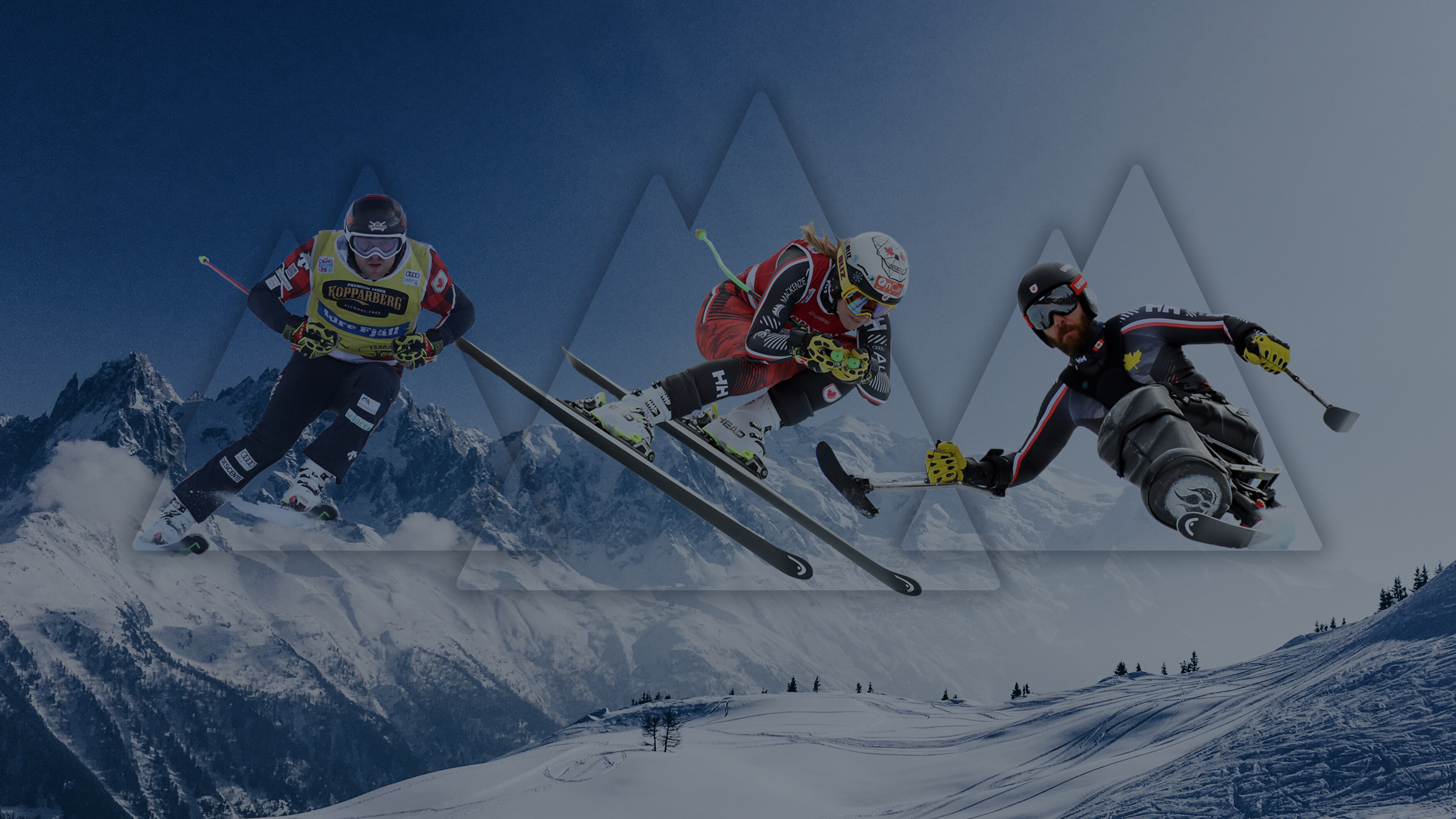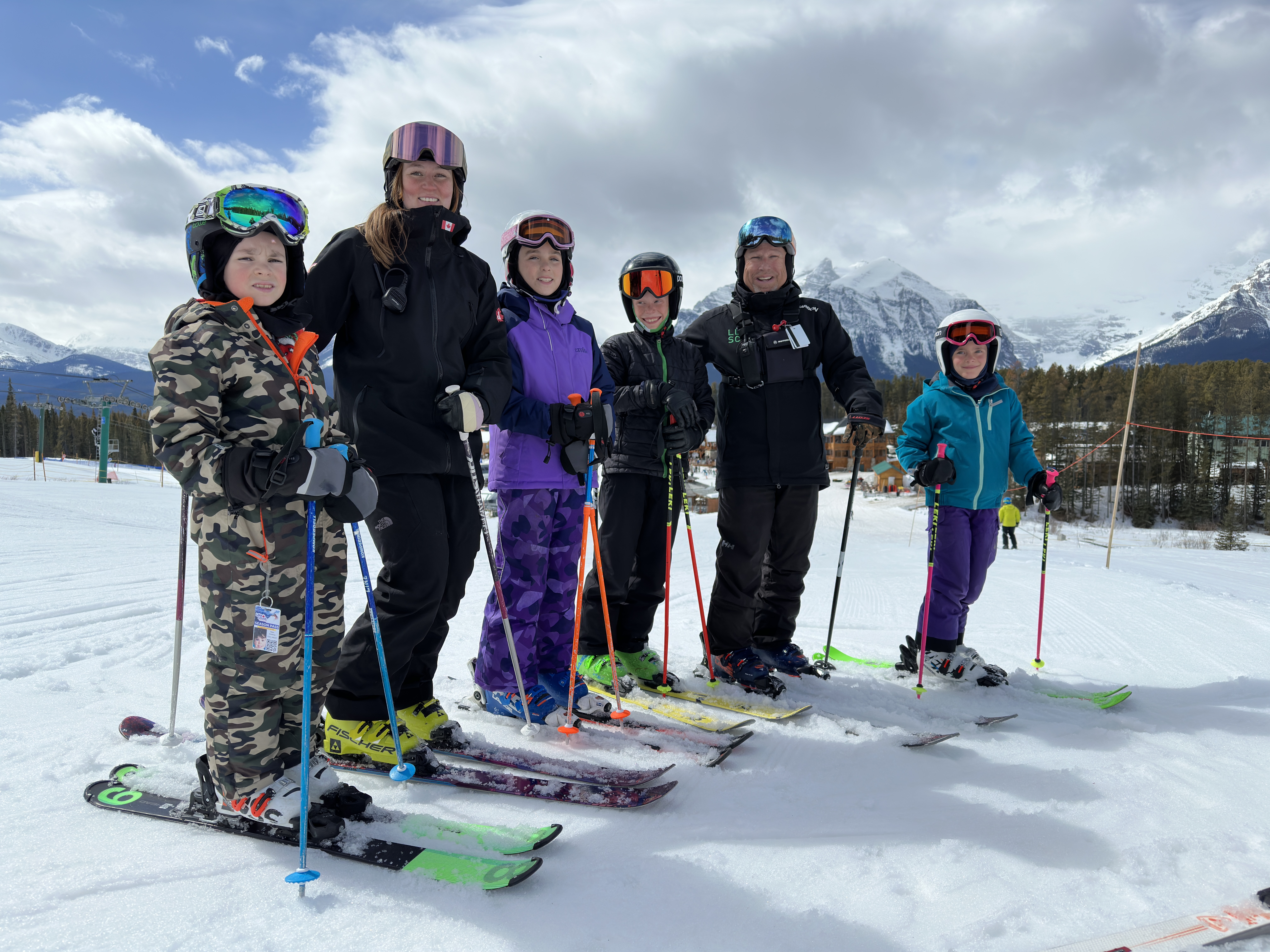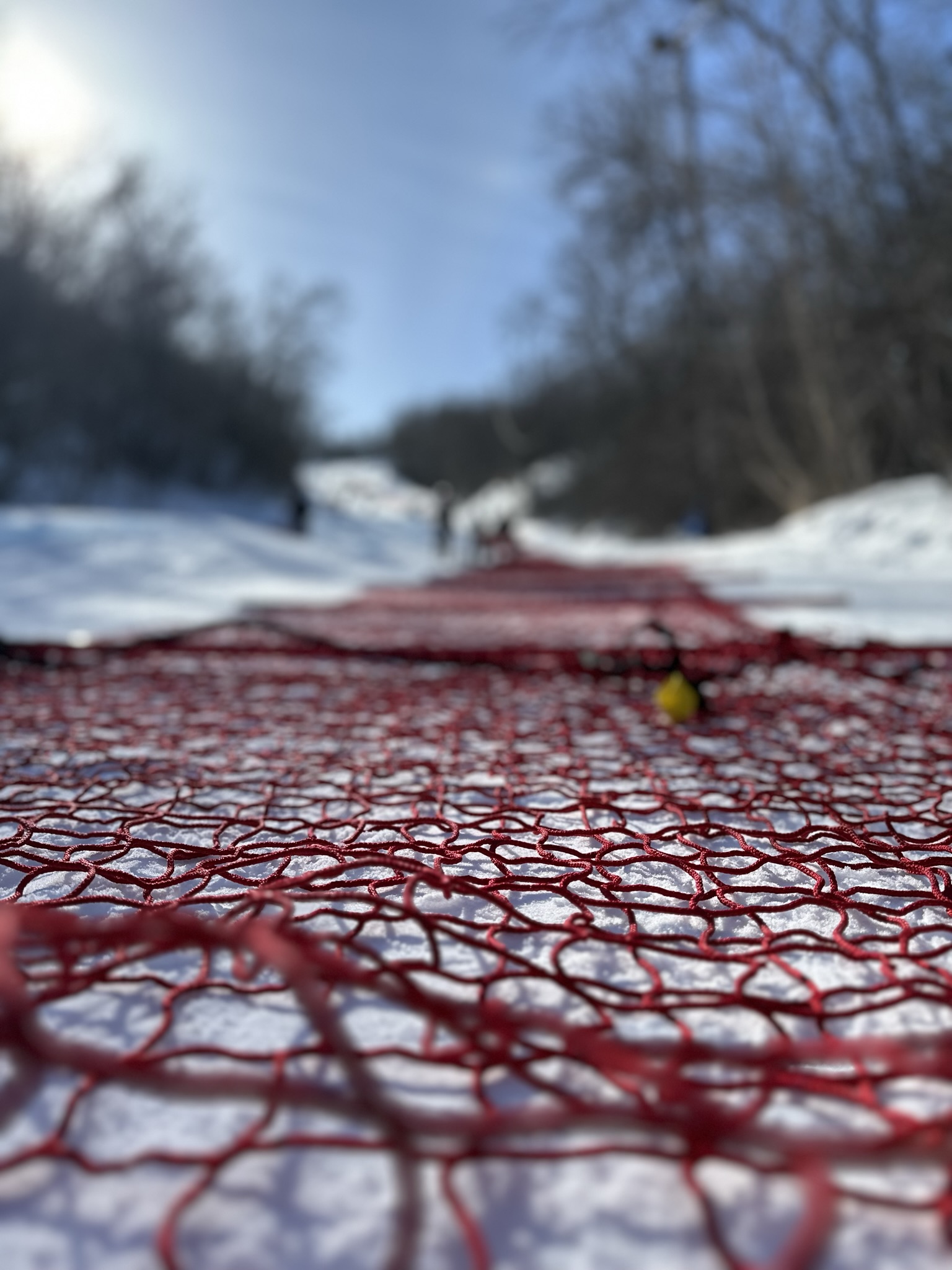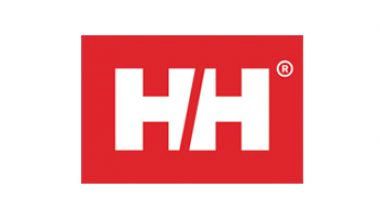About Our Sports
Alpine Canada is home to three of Canada’s fastest and most exciting snow sports: alpine, ski cross and para-alpine ski racing. Each ski discipline has a different set of rules, but each athlete has the same goal: get to the bottom of the mountain faster than anyone else.
Over the last half-century, Alpine Canada’s athletes have done just that – winning 29 world championship medals, 12 Olympic medals, 91 Paralympic medals, 12 X Games medals and dozens of World Cup podiums.

Alpine Canada and the Provincial and Territorial Ski Organizations provide the governance for the ski clubs to effectively operate within the ski racing system.
The ski clubs offer the day to day programs of developing well-rounded skiers and racers that may choose to pursue the sport to the elite levels. Ski clubs will vary in their philosophies. However, the one common denominator is that they want children to become great skiers that find exhilaration and enjoyment from the sport of skiing.
In our Strategic Plan 2015-2018, Alpine Canada has committed to strengthening the development pipeline and relationships with all its partners in Canada. Enhancing the development pathway occurs by enabling the clubs and provincial ski organizations to fulfil the objectives of creating exhilaration and enjoyment for children and their families while developing a talented pool of skiers that are equipped with the skill set to reach and excel at the elite levels.
Our vision is for Canada to be a world leader in alpine, para-alpine and ski cross racing by being solidly placed amongst the top nations of the international ski racing arena. The ultimate goal for all National Ski Federations is Olympic gold medals.
Alpine
It’s a simple concept: fastest skier from top to bottom wins. And if you strip it down to the essentials, it’s a pure sport. Because as much as alpine skiing has changed over the past 150 years or so, one thing has stayed the same. It’s about speed: electrifying, breathtaking speed.
Alpine ski racing is an action-packed sport that mixes speed, strength, agility, balance, coordination, technique and tactics into some of the Olympic Winter Games’ most popular events. Alpine ski racing emanates from the winter recreational activity of downhill skiing that provides skiers of all ages with a lifelong family pastime.
Although there have been significant advances in ski equipment and technology in recent times, the essence of the sport has remained constant. No judges are handing out scores; no marks awarded for style. It’s strictly a numbers game in which the time it takes a skier to go from start to finish, passing through a series of gates on the way down, determines the outcome of each race. In literal terms, alpine skiing – so called because it refers to skiing at or near the tree line – is the sport of sliding down snow-covered hills or mountains on skis.
There are several different kinds of alpine skiing, but it's divided into the six core disciplines ski racers compete in at the Olympic Winter Games.
DOWNHILL
Because it involves the highest speeds and, as a result, the biggest risks, downhill is the most glamorous of all the alpine disciplines. The world‘s best downhill skiers, including Canada’s own Erik Guay, are the sport’s rock stars. Downhill races feature the greatest vertical drop of all the alpine disciplines. Skiers can reach speeds of up to 130 kilometres per hour on a typical World Cup downhill course, but in individual sections of the famous Lauberhorn track in Wengen, Switzerland, and the Hahnenkamm course in Kitzbühel, Austria, they can go up to 150 kilometres per hour. On a typical downhill course, the gates are quite close together. Each course is designed to test skiing ability at high speed, through challenging turns, shallow dips, flats and jumps. The turns are strategically placed to control racers' speed. Downhill skis are longer than slalom skis, to provide more stability at high speed. Ski poles are bent to curve around the body as the racer stays in an aerodynamic “tuck position.” The most daring of all alpine skiing disciplines, downhill is also the most synonymous with the recreational sport of alpine skiing. Alongside super-G, it's often referred to as “speed skiing.” The title of downhill world champion is one of the most prestigious prizes in the sport of alpine skiing, and Canada has won medals in the men’s race at three consecutive world championships, which are held every two years. Jan Hudec earned silver in 2007 before John Kucera struck gold in 2009. With Kucera unable to defend his title in 2011 due to injury, Guay produced a spectacular run at Garmisch-Partenkirchen, Germany, to become the new world downhill champion.
SLALOM
If downhill is defined by speed, slalom is synonymous with technical ability. The world’s best slalom racers use aggression, strength and agility to make their way down shorter courses that feature the most turns of any alpine event. They must pass between poles that form a series of gates arranged in a series of different configurations. The skier with the best combined time from two separate runs is declared the winner. Because slalom skiers take a direct line and knock poles out of the way as they pass through (referred to as “blocking”), they wear protective equipment that includes shin pads, arm guards, padded gloves and face guards. On the women’s side, Canada has several young and talented slalom skiers, including Marie-Michèle Gagnon and Erin Mielzynski.
SUPER-G
Super giant slalom (or super-G, for short) combines the raw speed of downhill racing with the technical skill of slalom. It features long, sweeping high-speed turns on courses that have vertical drops only slightly less steep than in downhill. As such, it is referred to as a “speed discipline.” After first appearing in World Cup competition in 1982, it was added to the world championships two years later and made its Olympic debut in 1988. Canada’s Erik Guay took the Crystal Globe as the overall super-G World Cup champion at the end of the 2009-10 season.
GIANT SLALOM
As the name suggests, giant slalom features a longer course than traditional slalom, with at least 30 gates. Considered a technical discipline, giant slalom skiers use skis that are longer than slalom skis but shorter than downhill or super-G skis. Giant slalom features two runs – held on different courses on the same ski run. The skier with the fastest combined time wins.
SUPER COMBINED
Consisting of a shortened downhill or super-G run followed by a slalom run, super combined was introduced by the International Ski Federation in 2005. Before that, the traditional combined discipline comprised one downhill run and two slalom runs. In both forms of combined, the winner is determined by the fastest aggregate time. Although not technically a discipline, combined is referred to as the fifth alpine skiing discipline.
TEAM EVENT
The 2018 Pyeongchang Olympic Games mark the inaugural edition of the Team Event into the Olympics. This event features a mixed team of two men and two ladies competing for their National Teams in a head-to-head slalom with a knock-out format per round. Traditionally, 16 teams are at the start of the competition. The Alpine Team Event made its FIS World Championship debut in 2005, and in the parallel format in 2011. Canada claimed its first medal in this discipline at the 2015 World Championships in Vail/Beaver Creek, Colorado taking home silver.
Can you name all four alpine disciplines shown in this video?
Para-Alpine
Slalom and giant slalom were the only two alpine events at the first Paralympic Winter Games, held in Örnsköldsvik, Sweden, in 1976. Today, athletes with a physical disability compete in five alpine events: downhill, alpine combined, super G, slalom and giant slalom, and use some of the same venues as the women's World Cup circuit.
Para-alpine skiing has three main classification categories: visually impaired, standing and sitting. Male and female athletes with a physical disability such as a spinal cord injury, cerebral palsy, amputation and visual impairment compete within these categories.
It’s about speed: electrifying, breathtaking speed.
It’s a sport that requires great courage and skill in equal measure; strength, agility, balance and technique. And although there have been significant advances in ski equipment and technology in recent times, the essence of the sport has remained constant. No judges are handing out scores; no marks awarded for style. It’s strictly a numbers game in which the time it takes a skier to go from start to finish, passing through a series of gates on the way down, determines the outcome of each race. In literal terms, alpine skiing – so called because it refers to skiing at or near the tree line – is the sport of sliding down snow-covered hills or mountains on skis with fixed-heel bindings.
There are several different kinds of alpine skiing, but it is most commonly divided into the five core disciplines ski racers compete in at the Paralympics:
* Para-alpine skiing is governed by the International Paralympic Committee (IPC) through the International Paralympic Alpine Skiing Committee (IPCAS). IPC rules and regulations are used for all para-alpine events.
CATEGORIES:
VISUALLY IMPAIRED
B1 – Visual acuity is poorer than LogMAR 2.60.
B2 – Visual acuity ranges from LogMAR 1.50 to 2.60 (inclusive) and/or the visual field is constricted to a radius less than 5 degrees.
B3 - Visual acuity ranges from LogMAR 1.40 to 1 (inclusive) and/or the visual field is constricted to a radius less than 20 degrees.
In all visually impaired classes, a guide is mandatory; the competitor and the guide are a team. Blind skiers are directed down the course by guides skiing in front using only voice signals or radio communication.
No physical contact between the guide and competitor is allowed during the race. The distance between guide and athlete in slalom must be less three (3) gates and less than two (2) gates for GS, SG and DH, excluding delay gates and vertical combinations.
All guides must VI competitors from the front.
All competitors in the completely blind class (B1) must wear approved blacked-out goggles during the competition.
STANDING
LW1 - double above-knee amputees, or impairments that cause a similar loss of limbs
LW2 – single above or below knee amputation, or impairments that cause a similar loss of limb
LW3 - double below-knee amputees, or impairments that cause a similar loss of limbs
LW4 - single below knee amputation, or impairments that cause a similar loss of limb
LW5/7 – double above or below elbow amputation, or impairments that cause a similar loss of limb
LW6/8 - double above or below elbow amputation, or impairments that cause a similar loss of limb
LW9 – equivalent activity limitation of amputation in both upper and lower limbs
Athletes in certain classifications (example, single-leg amputees who ski without a prosthesis and sit-ski users) use special poles called outriggers. Outriggers have short ski blades on the end and help the skier with balance.
A complete listing of the classifications and other information can be found here
SITTING
LW10 - mono skiers (high degree of paraplegia, no control in the mid/lower body)
LW11 - mono skiers (lower degree of paraplegia, with limited core control)
LW12 - mono skiers (lower degree of paraplegia, possible lower incomplete paralysis)
Some athletes with a physical disability compete from a sitting position using a sit-ski, also called a mono-ski. As the name suggests, mono-skis have a specially fitted chair over a single ski. The chair includes seat belts and other strapping, as well as a suspension device to minimize wear and tear on the skier's body.
DISCIPLINES:
DOWNHILL
Because it involves the highest speeds and, as a result, the biggest risks, downhill is the most glamorous of all the alpine and para-alpine disciplines. Skiers can reach speeds of up to 130 kilometres per hour on a typical World Cup downhill course. Each course is designed to test skiing ability at high speed, through challenging turns, shallow dips, flats and jumps. The turns are strategically placed to control racers' speed. Downhill skis are longer than slalom skis, in order to provide more stability at high speed. Ski poles are bent in order to curve around the body as the racer stays in an aerodynamic “tuck position.” The title of downhill world champion is one of the more prestigious prizes in the sport, and Canada’s Mac Marcoux (guided by BJ Marcoux) won the title at the 2015 IPC Alpine Skiing World Championships held at Panorama Resort in B.C.
SUPER-G
Super giant slalom (or super-G) combines the speed of downhill with the turns of giant slalom. Like downhill, it is considered a speed event where racers take one run down the course. It features long, sweeping high-speed turns on courses that have vertical drops only slightly less steep than in downhill. The athlete’s one-run time determines the order of finish.
SLALOM
Slalom is a technical event. The world’s best slalom racers use aggression, strength and agility to make their way down shorter courses that feature the most turns of any alpine event. The skier with the best combined time from two separate runs is declared the winner. Because slalom skiers take a direct line and knock poles out of the way as they pass through (referred to as “blocking”), they wear protective equipment that includes shin pads, arm guards, padded gloves and face guards. The course is shorter than other alpine skiing events and has a high number of gates (50-75 gates). The penalty for missing a gate is a disqualification. Each athlete completes two runs on the same day on different courses. Times from the two courses are added to determine the order of finish.
GIANT SLALOM
As the name suggests, giant slalom features a longer course than traditional slalom, with at least 30 gates. Considered a technical discipline, giant slalom skiers use skis that are longer than slalom skis but shorter than downhill or super-G skis. Giant slalom features two runs – held on different courses on the same ski run on the same day. The skier with the fastest combined time wins.
SUPER COMBINED
Consisting of a shortened downhill or super-G run followed by a slalom run, the super combined event is an exciting race that showcases skills in both technical and speed events. Combined times determine the order of finish.
Ski Cross
The action-packed and adrenaline-fueled sport made its Olympic debut as a medal sport at the 2010 Winter Games in Vancouver-Whistler. Before the Olympics, ski cross had already established itself as a hugely popular TV sport thanks to events such as the X-Games.
While Ski Cross is still young, Canada has a rich history of success in the sport. Since 2009, Canada has been viewed as one of the strongest Ski Cross nations in the world, racking up 137 World Cup medals, 6 World Championship Medals, 15 X-Games Medals and 3 Olympics medals.
Ski cross courses have both naturally occurring terrain and artificial features. Course building is a type of art and always keeps the athletes on their toes. World Cup courses typically feature a combination of big jumps, small jumps, rollers and bank turns. In 2015 FIS also introduced a sprint race format, which is a short course offering multiple jump/roller lines for athletes to navigate.
Aside from the course, what sets ski cross apart from other sports, including alpine skiing, is the fact that many skiers are racing down the course. Four to six racers go head to head, at the same time, with the aim of finishing first.
The unique combination of technically-challenging terrain and head to head racing make ski cross a thrilling spectator sport.
FORMAT
In World Cup, World Championship and Olympic races, athletes complete a time trial qualification round, with racers skiing the course solo. Based on their qualification time, athletes are placed into brackets for heat racing. In heats, four athletes race head to head down the course, with the top two from each heat advancing to the next round. Finals consist of a small final, with athletes competing for places 5 to 8 and a big final which determines the winner of the race, following by 2nd, 3rd & 4th. At the Winter X Games – one of the sport’s most significant events – six skiers compete head to head in packs of four.
STAR POWER
Canada has some of the sport’s biggest stars. Veteran Chris Del Bosco has been a dominant and consistent performer at the highest level since 2009. To his name, Delbosco has 24 World Cup podiums, a World Championship title from 2011 and 5 X-Games medals. Marielle Thompson is the reigning ski cross Olympic Champion from 2014, and by the end of the 2015-16 season, Thompson has 23 podium finishes throughout her career. In 2012, Thompson made history by becoming the first Canadian to bring home an individual World Cup Crystal Globe in ski cross; a title she claimed again in 2014. Kelsey Serwa, 2014 Olympic silver medalist, 2011 and 2015 X Games gold medalist and 2011 World Champion, has also established herself as one of the best in the world. Brady Leman, who finished the 2015-16 season ranked third overall in the world, was crowned X Games champion in 2016. Leman has claimed 15 World Cup medals since 2012. Canada's deep roster of talent has led to multiple Nations Cup titles, awarded to the team with the most World Cup points and the end of a single season.


.jpg)


